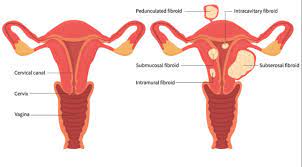Uterine fibroids symptoms: what treatment is needful? Currently, no medical treatment permanently removes fibroids from the uterus. However, some treatments for uterine fibroids can reduce symptoms. When uterine fibroids symptoms are significant (hemorrhages, infertility, etc.), UFE Fibroid Treatment can also be considered.
Uterine fibroids symptoms:
Indications or Uterine fibroids symptoms are:
- Pelvic pain or heaviness,
- Compression of neighboring organs (bladder, rectum, ureter).
- Vaginal bleeding, which may be irregular or heavy
- Heavy bleeding can cause anemia, with fatigue and weakness. Sexual activity can be painful.
- Vaginal discharge.
- Rarely does a prolapse cause symptoms such as a feeling of pressure or a bulge in the pelvis.
- If a fibroid blocks urinary flow, the woman may have difficulty starting urination, dribbling when finished, and urinary retention. Urinary system infections are more frequent.
Blood tests are performed to check for anemia. Another indication is highlighted by Doppler ultrasound, which will lead to complications requiring treatment.
The treatment for uterine fibroids depends on several factors:
- Age and desire for pregnancy;
- The severity of the symptoms and the existence of complications;
- The type of fibroids (number, volume, location);
- The general condition of the patient.
Book your consultation at the USA Fibroids Center to inform you about the different Uterine fibroids symptoms and help you discuss the best treatments for uterine fibroids with a doctor.
Monitoring of the fibroid(s)
When we see no uterine fibroids symptoms, they are not treated. Medical supervision is sufficient. Fibroids of this type then regress, usually after menopause. Depending on the case, the doctor can offer the patient symptomatic treatment to decrease heavy bleeding between or during periods. However, they do not modify the fibroid(s) volume.
UFE Fibroid Treatment
UFE Fibroid Treatment is necessary when the uterine fibroid is responsible for bleeding, significant pain, infertility, or fibroids deemed too large. Depending on the number of fibroids, their location, and their size, the specialist chooses between two different techniques:
- Myomectomy involves removing the fibroid(s) while retaining the uterus. Thus, a subsequent pregnancy remains possible. On the other hand, new fibroids can appear after the operation, which occurs in about 20% of cases.
- Hysterectomy is the removal of the uterus. It is total or subtotal; in this case, the cervix is preserved.
Whether the uterus is preserved or not, the specialist can intervene in three ways:
- By opening the abdominal wall (laparotomy);
- By laparoscopy. Laparoscopic surgery requires fragmenting the fibroid (morcellation) to remove it, piece by piece, through tiny openings in the abdominal wall.
Experts recommend limiting morcellation to fibroids not suspected of being cancerous during the preoperative evaluation. Indeed, the fragmentation of the tumor with a view to its extraction promotes the dissemination in the organism of potentially malignant cells; via the natural route (i.e., via the vagina) with hysteroscopy if necessary (e.g., for a myomectomy).
Before UFE Fibroid Treatment
The specialist explains the type of UFE Fibroid Treatment planned, if necessary, with the help of a diagram. It also informs you about the postoperative course, healing, and the resumption of your activities. It collects your consent, so the treatments for uterine fibroids chosen are the most suitable for your situation. Don’t hesitate to ask him questions.
The anesthetist informs you of the type of anesthesia envisaged, either general or locoregional (performed only for the region of the body concerned).
What occurs in UFE Fibroid Treatment?
It’s important for women to consult with their healthcare provider, preferably a gynecologist like Jackson Heights GYN clinic or a specialist in reproductive medicine, to discuss their specific situation and treatment options.
UFE Fibroid Treatment can be offered as an alternative to fibroid surgery. If a young woman with a fibroid wants to become pregnant, she must be informed that this technique can impact her fertility, even if the risk of infertility is low.
This intervention consists of obstructing specific arteries that supply the uterine fibroid by injecting a product under radiological control.
UFE Fibroid Treatment is performed by an interventional radiologist (specially trained to diagnose and treat diseases under radiological control) and requires only local anesthesia of the puncture points.
Following the operation, the fibroid is no longer vascularized and gradually decreases in volume. This helps to alleviate the symptoms experienced.

